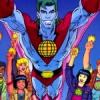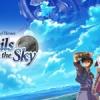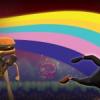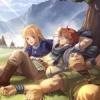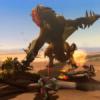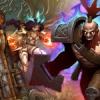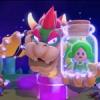JRPG developer Level-5 are behind critically acclaimed hits such as the Dark Cloud series, Dragon Quest VIII and most recently Ni no Kuni — a collaborative effort with Studio Ghibli. But every now and then Level-5 misfires and puts out a game like Rogue Galaxy.
Rogue Galaxy was a Playstation 2 RPG with a few technical innovations which came at a cost, several interesting sub-mechanics which weren’t given the chance to be fleshed out, as well as an interesting premise dragged down by poor execution and forgettable characters. To top it all off, a misguided “size matters” approach to design pervades every aspect.
To make matters worse, Rogue Galaxy was actually released twice (in Japan at least). The original version of the game had bugs and loading time issues that the successive Director’s Cut ironed out. It is this Director’s Cut that made it into the hands of non-Japanese consumers, and the version this review is based on. Keep in mind this is the better version of Rogue Galaxy; the one salvaged from the wreck of the original release.
The game starts on the desert planet Rosa, which is under the control of one of two warring intergalactic forces. You play as Jaster, a positive young-man who has always wanted to explore the galaxy; but the imposing military blockade prevents the people of Rosa leaving their planet.
One day the town is attacked by a giant beast and Jaster is given one of ‘the legendary star-swords’ by a mysterious stranger who happens to be the galaxy’s most famous bounty hunter (who then promptly vanishes). Jaster takes up sword and defeats the monster, but in the process of doing so is mistaken for being the aforementioned bounty hunter by a group of space pirates.
Recognizing an opportunity when he sees one, Jaster dons the bounty hunter’s identity and joins the pirates in their quest to find ‘Eden’; a planet thought to be host to unimaginable wealth.
And so began a promising quest of swashbuckling-in-space that ordinary-buckled under the weight of a painfully drawn out story.
The story and characters are largely unremarkable and wholly under-developed. You never get the sense of camaraderie that you’d expect with a pirate tale - look to Skies of Arcadia for an example of how it should have been handled. It’s passable, but falls down due to how artificially padded-out plot developments are; it’s not until about 30 hours in that the game starts to pick up pace. If there’s a saving grace to all of this, it’s that the story doesn’t play out the way you might expect. Jaster doesn’t leave his desert home world and defeat an evil empire; the war resolves itself fairly early on and Jaster’s fate ends up tied to much bigger things.
Travel between planets is handled via a menu system accessed from your ship, which serves as a hub area of sorts. You can roam around the interior and chat with party members, but other than that it doesn’t really serve much function.
Whilst you run around the various worlds there are no load times; not when you get into one of the games many random encounters, not even when transitioning between indoor and outdoor areas. This was a remarkable feat of technical engineering for the time.
But playing it today, the technical compromises that had to be made to pull this off become are all too obvious. The game hides what is being streamed in behind well-placed corners. The end result is a game world which breaks down into a series of extremely same-y looking tunnels and straight-lines. Environments are largely featureless, bar the odd treasure chest dotted around
Exploration becomes repetitive and a sense of déjà vu sets in when running through these enormous levels. Since everything looks the same, you’ll spend most of your time navigating using the mini-map rather than your own sense of direction.
When running around you’ll occasionally be drawn into battles which take place in the field; a warning sign will flash on screen and enemies rise up out of the ground as if it’s the beginning of a zombie apocalypse.
Battles play out in real-time, and you’re provided with full three-dimensional control over your character. You control Jaster by default, but you have the option to switch between party members on the fly. There are 8 playable party members in total, but you’re only able to have 3 in your group at any point in time - requiring a lot of switching characters in and out in order to ensure that they all remain competent.
Your options for ass-kicking are a close-range main-weapon, or a long-range sub-weapon. In addition, you can pause the action, enter a menu and select a spells or items. There is a lot of potential here but—in what is a running theme that holds true for most of the game—it’s potential that Level 5 squandered.
The game hints that you’ll defeat bosses in unique and interesting ways; for example, you get a gun near the beginning of the game that creates platforms, making it possible to scale bosses…which is almost never used again; something true of most of the other exotic weapons in the game. The freeze gun that was really useful that one time is only useful that one time.
There is one weapon you use frequently though: a shield-breaking gun; but doing so reveals a design oversight. It’s quite baffling that you’re expected to go into the menu to manually switch between your damage-dealing gun and your shield-breaking-gun. It is even more baffling, because this functionality could have easily been mapped to the d-pad, which has been reserved for important actions like… doing nothing.
It’s a minor nuisance, but one that is persistent throughout the second half of the game, where shielded enemies routinely enter battle alongside their unshielded counterparts.
The camera can also be a nuisance when you get your back up against a wall, often choosing the worst possible angle at the worst possible time. Poor 3D cameras are nothing new to games of course, but the camera in Rogue Galaxy is particularly annoying. Fortunately, the game stocks you with a very generous supply of healing items so you’re unlikely to be killed by an enemy because the camera has decided to show you anything except for the monster you need to be focusing on.
The combination of a low difficulty, repetitive battle strategy and arduously long trawls through indistinct locations comes to a head in a massive dungeon during the mid-point of the game. This dungeons stands as a monument of dull-game design. It’s very hard to feel a sense of exploring a planet, let alone a galaxy, when the areas are so clearly the copy-pasted work of a game designer and not a living, breathing world. The gameworld comes off as contrived, barren and overly-massive all at the same time.
Bigger is not always better — that is true not only of the level design in Rogue Galaxy, but the leveling design. For example, you can level up weapons and then combine them when they are fully leveled to create new, more powerful weapons; you can create items that don’t exist in the game world and populate the galaxy’s shops with them through a complex mini-game; and you can kill scores of a certain enemy (or one of the games many optional bosses) to rank up your galactic bounty-hunter status for rewards.
The problem, however, is that although you can do all these things, the XP thresholds required to level up characters and weapons feel excessive, and bounty quotas are set too high to make them compelling. If handled correctly, these elements would have been just within the players reach with minimal grind - carrots-on-a-string, nudging the player on towards the next level-up, new weapon or bounty reward. Instead everything feels so far away that these sub-systems become a secondary consideration, and it hurts the pacing of the game. Without a satisfying sense of character progression and reward, boredom soon sets in.
These mechanics end up serving a decorative function, making the game feel full but without any practical reason to exist. They are yet more examples of areas where the game’s bloated design creates the impression of size, but doesn’t have the substance to back it up. Sometimes less is more, and that is a lesson that Level 5 should have taken on board when creating Rogue Galaxy.
Outside of the main storyline, a number of minigames and optional activities provide additional distractions. You can search for missing artifacts and participate in challenge battles that ask you to defeat your foes under certain conditions. There’s also a Pokémon-esque side-activity, with the game containing over 120 different critters that can be captured, trained and entered into battle against each other.
While these are all nice additions for when you get bored of running through yet another lifeless dungeon, they never really come into their own, resulting in them becoming little more than collecta-thon aspects shoehorned in for the sake of it. The result is that they never feel engaging enough to make you want to indulge in them; ultimately, they feel superfluous.
This second version of Rogue Galaxy offered the developer a second chance to fix some of the biggest flaws in the game’s design. But it’s a chance that was squandered. It’s a shame, because it feels like there was a good game hiding inside Rogue Galaxy. But that game would have been a tight, bloat-free 30 hour roller-coaster of plot developments and leveling up, instead of a meandering, glacially-paced 100-hour slog.
Despite positive critical reception at the time of its release, playing it again now, nearly seven years later, I’d be surprised if many people look back on Rogue Galaxy too fondly. It wasn’t terrible for its time - and there were far worse RPGs released during the PS2′s lifespan - but it hasn’t dated all that well. You’d be far better picking up something like SteamBot Chronicles, or one of the Atelier Iris games, which have aged considerably more gracefully.
If you do decide to play it again, or decide to play it for the first time after picking it up secondhand, I’d urge you to play the game from start to finish, rather than dipping in for a little while and forming your verdict before reaching the closing credits. Spend your hundred-or-so hours mining the game’s content, come back to this review, and then tell me if you come away from Rogue Galaxy feeling as though Level 5 respected your time.


